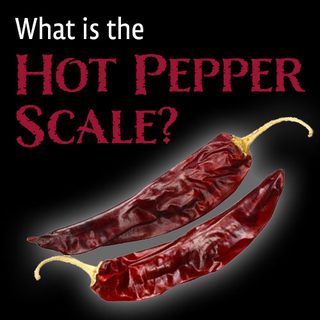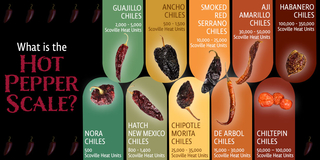What is the Hot Pepper Scale

There are so many varieties of peppers - from the mild green and sweet red peppers to the fiery Habanero peppers. So when you are shopping at your local market - how do you know which pepper will provide just the right amount of heat for your dish?
What makes a pepper hot?
Chiles contain an alkaloid called capsaicin, which puts the heat or burning sensation in hot peppers. Capsaicin is a compound made of capsaicinoids that are insoluble in water, tasteless and odorless. Of the components that combine to create the capsaicinoids, some cause the intense heat or ‘bite' at the back of the mouth and throat while others produce the slow burn on the front and mid area of the tongue. Some chiles contain more capsaicin than others, therefore creating the difference in intensities and heat. It is a misconception that drinking water after eating a hot pepper will help dilute the heat from the pepper. In fact, capsaicin is an oil and does not mix with water but instead will distribute heat to more parts of the mouth. To counteract the intense heat from a hot pepper you could drink milk, rinsing the mouth with it while swallowing. Eat rice or bread, which will absorb the capsaicin. Drink tomato juice or eat a fresh lime or lemon (the acid will counteract the alkalinity of the capsaicin).
The heat of the chile is concentrated in the interior veins or ribs, not in the pepper seeds as is commonly believed. The seeds are hot because they are in close contact with the hot veins. By removing the pepper seed clusters and the white ribs attaching the seeds to the flesh of the hot pepper, you will reduce the heat of the hot pepper.
What are Scoville Heat Units?
In 1912 a chemist by the name of Wilbur Scoville, working for the Parke-Davis pharmaceutical company, developed a method to measure the heat level of chile peppers. The test is named after him, the "Scoville Organoleptic Test". The test is a subjective dilution-taste procedure in which pure ground chilies were blended with drops of sugar water. Testers tasted the mixture adding more drops of the sugar water until the tester could no longer feel the heat and the chile no longer burned the mouth. A number was then assigned to each chile pepper based on how much it needed to be diluted. This measurement of millions of drops of water-sugar solution is then translated into Scoville Heat Units (SHU) in multiples of 100.
The sweet bell pepper is the mildest of the hot peppers at zero SHU while the jalapeno is in the 2,500 - 8,000 SHU range and the mighty Habanero is much hotter in the 100,000 - 350,000 SHU range. Pure Capsaicin tops the scale at 15,000,000 - 16,000,000 SHU.
Although the Scoville Organoleptic Test has been criticized due to it's subjective technique and more scientific methods have been developed, the Scoville Heat Unit of measure is still the standard when determining the heat of the chile peppers.

